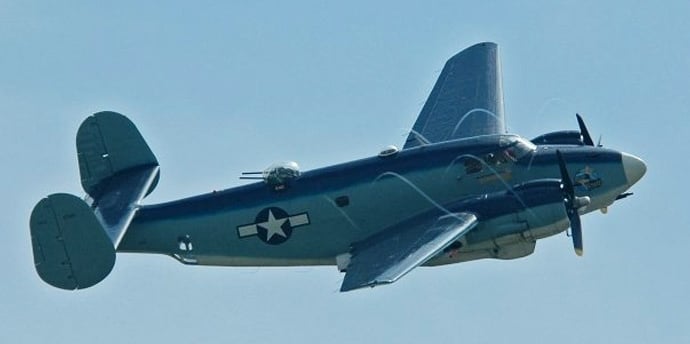Island Doll History
PV-2 Historical Timeline
The United States Navy Bureau of Aeronautics Lockheed PV-2 Harpoon 37396 (BuAer37396) was built at
the Lockheed plant in Burbank, California with its first flights on March 11, 1945. March 16th it was
ferried six minutes and seven miles west to Lockheed’s Van Nuys facility for delivery to the Navy and for
further outfitting and testing. April 9 th and 10 th saw the last of the flight testing, ending up at San Pedro
Naval Air Base on Terminal Island, which is now part of the Long Beach harbor complex. Over the 11th to
13th the aircraft was ferried to Naval Air Station (NAS) Quonset Point, on Narragansett Bay in Rhode
Island.
At Quonset point the Navy did a test flight, a number of repairs, updates and inspections over the span
of two months, another test hop, and then transferred the plane back to the factory for modifications.
That trip ran from June 11 th through the 14th , modifications and a test flight were made, and the aircraft
was returned to the Navy July 21 st . The plane immediately left for NAS Whidbey Island in Washington
state, arriving the next day, where it was assigned to Fleet Air Wing 6 (FAW-6), Patrol Bombing Squadron
136 (VPB-136).
VBP-136 had brought their Lockheed PV-1 Venturas, an earlier design, down from the Aleutian Islands to
exchange for and train on the new PV-2 Harpoons. The training had been in full swing when the atomic
bombs were dropped on Japan in early August, but the aircraft apparently suffered significant damage
about the same time resulting in entire tail section being replaced by August 8 th . The war ended on
September 2, 1945, and with it any urgency to get the airplane into active service.
FAW-6 was ‘de-established’ on December 1 st and the aircraft was transferred to FAW-4. More, and
extensive, repairs were completed on December 4 th , apparently due to a tail wheel collapse. December
5 th saw a test flight, and on the 7 th the engines were preserved for storage.
February 7, 1946 saw the Harpoon make a short ferry flight to NAS Seattle on Puget Sound where the
plane sat for an extended period and on September 27, 1946 it was administratively transferred to Fleet
Aircraft Service squadron 112 (FASRON-112). On May 17, 1947 it was ferried to NAS Alameda and
preserved for storage.
July 13 and 14 1948 saw short flights, and July 20 th an overhaul of the aircraft was completed, with
overhauled engines and props installed. August 3 rd and 4 th the plane ferried back to its old squadron at
NAS Seattle, Washington. The squadron had been redesignated as Patrol Squadron 136 (VP-136), and
the plane was busy through early October with crew training and checking, reconnaissance, anti-
submarine patrols, and personnel transport. However, the aircraft suffered significant damage, perhaps
through an accident on the ground, as the plane did not fly again until December 22 nd . In the interim a
section of the left wing, the wing tip, aileron, left horizontal and vertical stabilizers and the left rudder
were all replaced and multiple lesser repairs were made.
January and February 1949 were quite slow but the second half of March was very busy with the plane
being airborne 10 to 12 hours per day on multiple occasions, perhaps due to a conflict in South Korea.
At the end of May the Harpoon was transferred again, this time to NAS Los Alamitos in the Long Beach,
California area. There it was moderately busy training and had its planned retirement postponed
several times. At the end of April 1951 it had another overhaul and engine and propeller swap.
Immediately following the overhaul, it transferred to NAS Willow Grove, just north of Philadelphia, PA.
There the flying, mostly training with some operational work, was busy one month and slow the next. It
also received a complete repainting March 6 th , 1953. It stayed active through October, when it received
another service tour extension, but structural damage was found in the aft of the aircraft. A temporary
repair was made and the plane was transferred to NAS Corpus Christi, Texas, for another overhaul. Post
overhaul test flights were made in February 1954, and the aircraft was immediately ferried to Naval Air
Facility Litchfield Park, now the Phoenix Goodyear airport, where it was put into long term storage on
February 20 th with a grand total of 1,551.1 hours of Navy service over nine years.
The Harpoon started its civilian life in November 1957 with a ferry flight to Douglas Arizona, on the
Mexico border. It sat there until July of 1969, when it ferried to Bainbridge, Georgia. Sometime after
that it was used to spray chemicals for fire ants before it spent some time at a museum in Houston for a
bit, ultimately coming to Indianapolis in the 1980’s.


Historic airplane preservation
History
Preserving a rare Lockheed PV-2 Harpoon aircraft
Support
Donate
Staff@islanddoll.org
© 2024. All rights reserved.
